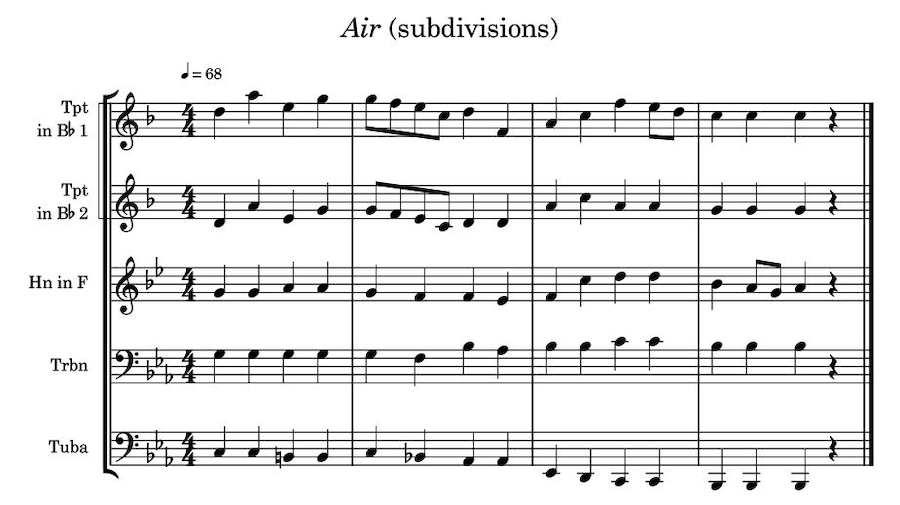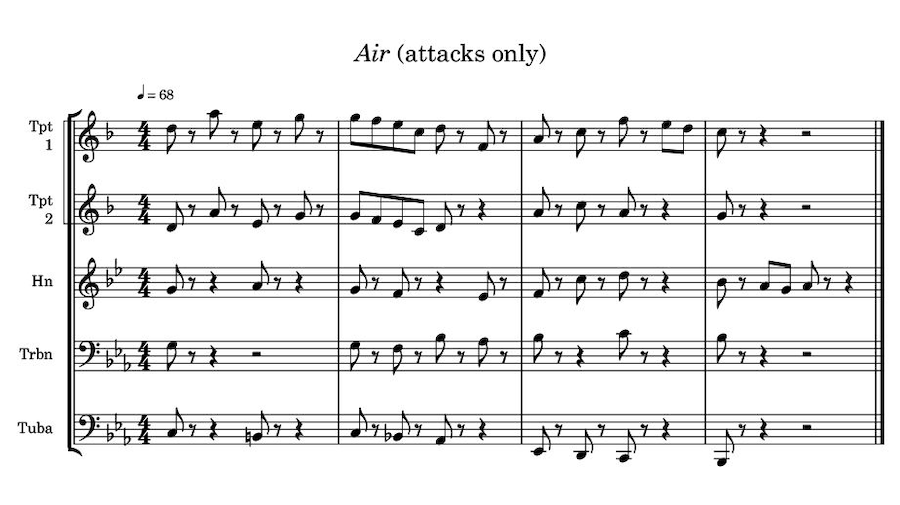Strategies For Developing Strong Internal Pulse
Strategies For Developing Strong Internal Pulse

The glue that holds the music together
A solid and unified sense of internal pulse is a foundational skill of effective ensemble performance. As I often tell student ensembles: “A right note in the wrong place becomes a wrong note!” Dr. Rob McWilliams suggests some warm-up and rehearsal strategies that can help to develop this skill.
Feeling it out
It is important to teach ensemble musicians to take responsibility for feeling the pulse, and to find ways for the players to develop a heightened sense of ensemble awareness in this aspect of performance. It is important that they can play together without relying on a visual beat (i.e. without a conducted pulse). When an ensemble takes responsibility for feeling and holding steady pulse, the conductor’s beat becomes more of a reinforcement — or confirmation — of the pulse, that the individual players are feeling internally and uniformly across the ensemble. Situations that do require the conductor to have control of the ensemble’s pulse and ensure the players follow visually as well as listen, are when the pulse changes i.e. tempo changes, accelerations, decelerations.
Inexperienced players often place their attention solely on their own part, with little or no awareness of anyone else playing with them. It is an ongoing teaching and rehearsal goal of mine to find as many ways as possible to make the players accountable for feeling the internal pulse, while also raising their awareness of their fellow ensemble members. As with many of my rehearsal strategies, I look for ways to achieve these goals by guiding player listening that addresses the targeted skill.
For a more general discussion on warm up strategies, the reader is encouraged to read my previous article: Warm-ups to Develop Better Tone, Intonation & Ensemble Pulse.
As mentioned in that article, training of pulse and rhythm skills can benefit immensely by working on them away from the instrument, using strategies such as counting, singing, saying syllables, clapping, moving. I often refer to an axiom: “Train the instrument in the head before the one in the hand.” Developing the strongest possible mental image of the desired result (audiation) before adding the complexities of manipulating an instrument, always seems to make most things work better when you finally do move back to playing the instrument.
Exercises to train and develop internal pulse
GROUP A: Exercises that address audiating silent pulses (not conducted)
1. Counting (out loud) that incorporates silent beats
In this exercise students count aloud selected beats, and exercises are developed that incorporate silent counts which are, therefore, felt internally but not audible. Such exercises would sound like the following where numbers in parentheses are silent. No audible foot tapping allowed (silent toe movement inside shoes is okay if desired).
Note: When reading these exercises, () denotes a silent beat.
a. 1,2,3,4 |1,2,3,4 |1,2,3, (4) |1,2,3,(4) |1,2,(3),(4) |1,2,(3) (4) |1,(2),(3),(4) |1,(2),(3) (4) |
b. 1,2,3,4 |1,2,3,4 |1,(2),3 (4) |1,(2),3,(4) | etc.
c. 1,2,3,4 |1,2,3,4 |1,(2),(3), 4 |1,(2),(3), 4 | etc.
A useful variation on the above can be to set up the counted beats with the “and” (2nd half) of the pulse. This can help emphasise beat subdivision and encourage players to then audiate the subdivision on the inaudible pulses. This can be especially effective if you use it at slower tempos.
For example:
d. 1&, 2&, 3&, 4& |1&, 2&, 3&, (4&) |1&, 2&, (3&),(4&) |1&, (2&),(3&),(4&) |etc.
Once these can be executed successfully away from the instruments using verbalisations, all of the above exercises can also be played at the very beginning player level using a single note, alternating between two notes. For players beyond the beginner level, the exercises could be applied to scales, arpeggios, etc.
GROUP B: Strategies that can apply to pulse/rhythm issues in rehearsal repertoire
The following short excerpt based on Air For Band by Frank Erickson will be used to show a few possible strategies that might be used to help with pulse and rhythm issues:

1. Simplify the non-rhythmic aspect
One possible strategy involves simplifying the non-rhythmic aspect of the parts and having the performers play the rhythm of their part on a single pitch. The goal here is to increase attention and awareness of just the rhythmic component. The above example would sound like the following using this strategy:

2. Play the internal subdivisions
For passages with notes spanning longer than the primary pulse it can sometimes help to have the performers play the internal subdivisions rather than the fully sustained values. For example, a minim becomes 2 crotchets, a semibreve becomes 4 crotchets, etc. The goal here being to have the players feel the pulses within a longer note, and listen for those to line up with other ensemble members who are also pulsing these beats. When the passage is then played as written, the players are hopefully more aware of, and paying more attention to, these internal subdivisions. The example would sound like the following using this strategy:

3. Just play the attack
Another strategy that is very useful, particularly in slower music of a legato and sostenuto style, is to have the performers play just the attack of every note with no sustain beyond the initial articulation. Encourage them to play with more of a “dah” syllable, so that there is a decent tone quality with good pitch information. This often sounds quite humourous but it really helps to focus attention on exactly where the note is placed rhythmically, such that I find there is always at least some improvement (and often a significant amount) in precision after using this strategy. The example would sound like the score below:

4. Utilise “sizzling”
One final suggestion relates to the use of rhythmic “sizzling” as another means to focus players’ attention to pulse and rhythm issues. Sizzling is simply sounding rhythms with a “ch” syllable. While clapping and counting are also valuable strategies, I like to use sizzling more often because players can execute every aspect of their notated parts other than pitch. Rhythm, duration, dynamics, and articulations can all be emulated through sizzling.
It also helps to save “chops” if they are tiring (handy on the day of a concert to get good rhythmic focus without embouchure strain). When working a subsection of the ensemble on a rhythmic/pulse issue, I often have the resting players help by sizzling the underlying pulse as a kind of “metronome” for the segment you are working. This has the added advantage that the non-playing part of the ensemble is not only more actively engaged in the rehearsal process, but they can’t fall into idle chatter with other resting colleagues as their mouths are otherwise engaged!
A further advantage of the ensemble sizzling their parts is, due to the relatively softer volume, you can verbally communicate to them “in flight” (i.e. as they are sizzling) with reminders about things like balance, dynamics, articulations, etc. in the places where these reminders are needed. All of the above strategies for working on pulse with instruments can also be executed with sizzling to help strengthen and reinforce the internal audiation of what you are trying to achieve away from the instrument.
Final words
As most ensemble music to be played at school and community levels will be held together through regular pulse and beat, it is very important that ensembles are taught to pay close attention to the accuracy of this aspect of performance. High quality ensembles of all sizes and types develop and work on feeling and sensing a unified ensemble pulse (whether conducted or not) in order to perform with good precision. As such, I believe this same attribute can, and should, be developed in learning to be a competent ensemble musician at all levels of learning from beginner onwards.
As Yamaha Music Australia’s Education Outreach Clinician, Prof. McWilliams is engaged by Yamaha to work with wind bands, orchestras, jazz bands and their directors (educational institutions and community) as a professional development resource. To arrange a visit under this program, please contact Dr. McWilliams directly at: robert.mcwilliams@music.yamaha.com
WORDS BY: Dr. Rob McWilliams

WORDS BY: Dr. Rob McWilliams
Rob McWilliams, Ph. D., has worked in instrumental music education and ensemble direction at secondary and tertiary levels in Australia and the USA for more than 30 years. He is currently the Education Outreach Clinician for Yamaha Music Australia.
